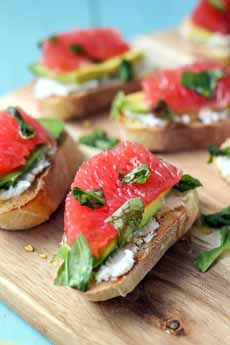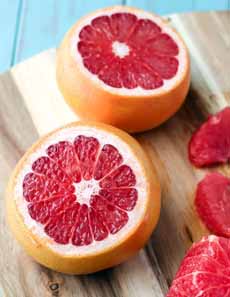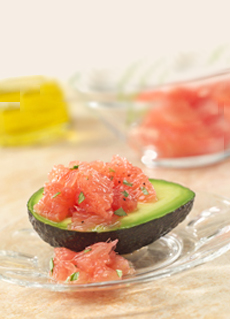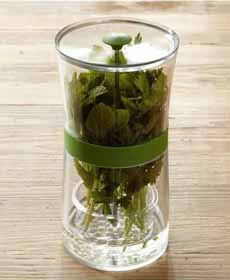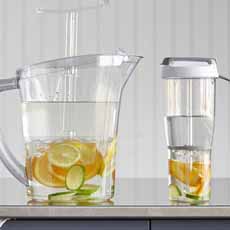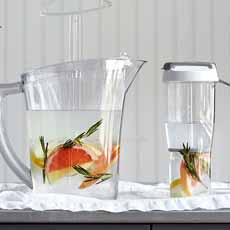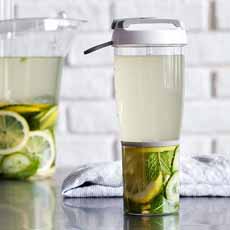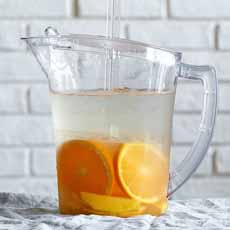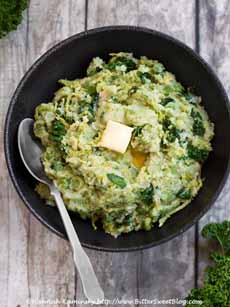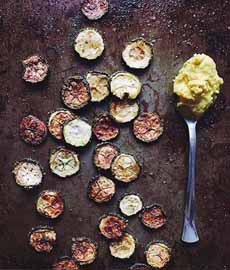|
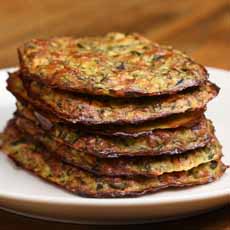
[1] Zucchini and onion hash browns (photo courtesy Tasty).

[2] Grated zucchini using a box grater (photo courtesy DVO).

[3] Grated carrots using a food processor (photo courtesy Once Upon A Chef).

[4] Dice-cut hash brown potatoes with onions and bell peppers (photo © Scukrov | Panther Media).

[5] Thin-sliced hash brown potatoes with bacon and eggs (photo © Lynne Ann Mitchell | Panther Media).
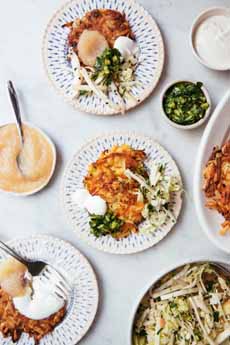
[6] Potato latkes served with apple sauce, sour cream, and slaw (photo © Good Eggs).
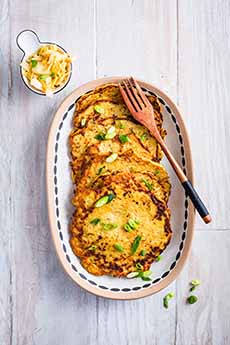
[7] Kartoffelpuffer, German potato pancakes (the word translates as potato fritter), shown here with cabbage slaw (photo © Brebca | Panther Media).
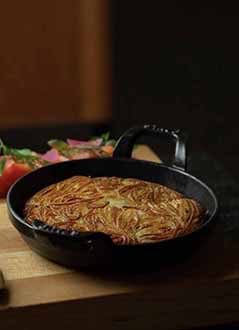
[8] Rosti potatoes, a Swiss specialty, are usually cooked as a whole pancake before slicing into individual portions (photo © Crown Shy | New York).
|
|
If your palate says Hash Browns! but your mind says Cut Carbs!, here’s a solution: Substitute grated carrots, zucchini and/or chopped spinach—or a combination—for the potatoes.
You save the potato carbs and, because these hash browns are baked, not sautéed/pan fried*, you save the fat, too.
This recipe, adapted from Tasty, uses an egg and grated cheese to bind the grated vegetables. You can serve them with eggs and/or breakfast meats, enjoy them as a vegetarian lunch with condiments of choice and a salad, or serve them as a side with dinner.
> National Hash Brown Potato Day is March 8th.
> The history of hash brown potatoes is below.
> So is the difference between hash brown potatoes and potato pancakes, latkes, and rosti.
> The history of potatoes.
RECIPE: ZUCCHINI, CARROT OR OTHER VEGETABLE HASH BROWNS
You can serve this recipe broken up like conventional hash browns, or in the shape of potato pancakes, as seen in photo #1.
Ingredients
2 zucchini (or equivalent vegetables of choice)†
Salt, to taste
½ onion, grated
½ cup Parmesan cheese, grated (we used Gruyère)
⅓ cup fresh chives
1 teaspoon dried oregano
¼ teaspoon black pepper
¼ teaspoon garlic powder
1 medium or large egg
Optional garnish: julienned basil, minced chives, minced parsley
Preparation
1. PREHEAT the oven to 400°F/200°C. Place a baking sheet in the oven as it heats. This added heat will make the hash browns crisper.
2. USING a food processor with the coarse grating blade, or the coarse side of a box grater, grate the zucchini or carrots, as well as the onion, on the coarse side. If using spinach, see the *footnote below.
3. PLACE the grated zucchini in a large bowl and sprinkle with salt. Blend and set aside for 20 minutes; the salt will draw moisture from the zucchini. Then transfer the zucchini to paper towels and press lightly to remove the remaining moisture.
4. RETURN the zucchini to the bowl and toss in the remaining ingredients. Mix until well combined. Form the mixture into 6 patties.
5. REMOVE the baking sheet from the oven and line with parchment. Place the patties on the baking sheet. Bake for 35 minutes, turning halfway through, until golden brown.
5. REMOVE from the oven. If the patties are too soft, let them cool for 10 minutes, to set.
THE HISTORY OF HASH BROWN POTATOES
Hash brown potatoes originated in the U.S. in the late 19th century. The dish consists of grated or diced potatoes that are fried until crispy and golden brown.
The term “hashed brown potatoes” first appeared in print in the 1890s, likely derived from the French word hacher, meaning “to chop.” Early recipes describe them as “hashed browned potatoes,” emphasizing the process of chopping and browning them in a pan.
While hash browns are a classic American breakfast dish, they have roots in middle-European cuisine, such as Jewish latkes and German Kartoffelpuffer. (Unlike hash browns, however, these are often eaten with applesauce or sour cream.)
By the early 20th century, hash browns became a popular breakfast dish in American diners and hotel restaurants. As the breakfast culture grew, including diner breakfasts, hash brown grew with it.
In the 1950s and 1960s, mass production of frozen hash browns made them even more widespread, both for consumers and restaurants.
Today, hash browns are a staple breakfast item across the U.S. and many other countries, served in various styles, from shredded and crispy to cubed or formed into patties.
THE DIFFERENCE BETWEEN HASH BROWNS & POTATO PANCAKES
Hash browns (photos #5 and #6) and potato pancakes (photo #7)can be similar in flavor, but they differ in texture, ingredients, and cooking methods. In some preparations, it’s hard to tell the difference.
Ingredients
Hash Browns: Primarily just potatoes, salt, and sometimes onions. Some versions may use a small amount of starch or butter for crispiness.
Potato Pancakes: Often include eggs, flour, onion, and sometimes milk or baking powder, making them more of a batter-based dish.
Texture & Preparation
Hash Browns: Typically made from shredded or diced potatoes, which are lightly seasoned and fried until crispy. They are usually not bound together with additional ingredients.
Potato Pancakes: Made from grated potatoes mixed with binders like eggs and flour, which help hold them together in a patty-like form. This results in a denser, slightly softer texture inside.
Cooking Method
Hash Browns: Typically fried in a pan as a loose pile of potatoes or shaped into a patty, cooked until crispy on both sides.
Potato Pancakes:: Fried like pancakes, often in a little more oil, resulting in a crisp exterior and a soft interior.
The Difference Between Hash Browns & Rosti Potatoes
While very similar, Swiss-origin rosti potatoes (photo #8) and has browns are not exactly the same as hash browns.
Rosti uses pre-cooked, grated potatoes that deliver a softer texture, while hash browns can use raw grated or diced potatoes.
Rosti is often formed into a larger, thicker pancake-like patty that consumers the entire skillet, and then are cut into wedges like a pie. Hash browns are shaped and fried as individual patties.
The Difference Between Latkes & Potato Pancakes
Both are potato fritters, but latkes tend to have a crispier exterior and a slightly coarser texture due to the grated potatoes used. Latkes add baking powder, matzo meal, and often, grated onions.
Potato pancakes are often simply raw grated potatoes, all-purpose flour, and egg as a binder. might be smoother and can have a more mashed potato-like consistency, depending on the recipe.
Latkes are strongly identified with Jewish cuisine, while potato pancakes of various descriptions are found in various cuisines. Irish Irish potato cakes, for example, are made from leftover potatoes.
________________
*Sautés and pan-frys are almost identical. The only meaningful difference is that in a sauté, the food is cut into small pieces, like sautéed mushrooms. A pan fry denotes larger pieces, like a chicken breast.
†When sliced, 1 medium zucchini yields about 1 to 1.25 cups. If grated, it yields about 2/3 cup of tamped down zucchini. Thus, 2 medium zucchini equals 1-1/2 cups of grated zucchini. It takes about 2.75 medium carrots to obtain 1 cup of grated carrots. Thus, plan on 3-1/2 carrots. One package (10 ounces) of frozen chopped spinach yields about 1-1/2 cups after cooking, but to eliminate all the water and tamp down, plan on two packages. Information from How Much Is In.
|
